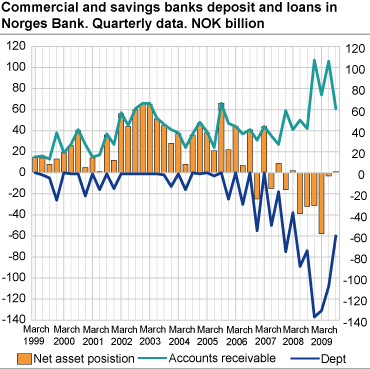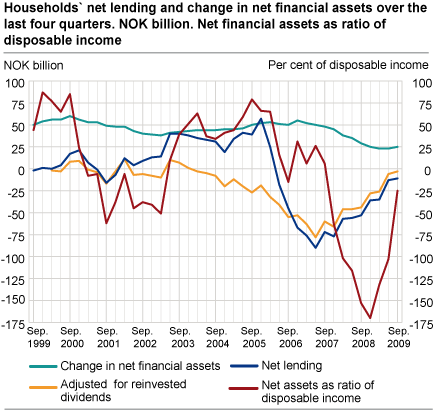Content
Published:
This is an archived release.
Huge net holding gains in the two last quarters
The central government and households both had huge holding gains in the third quarter of 2009. The positive development from the second quarter continued. The central government’s holding loss since autumn in 2007 has been reduced by almost 50 per cent.
Central government's net holding gains totalled NOK 422 billion, while households’ net holding gains amounted to NOK 35 billion over the two last quarters. The accrued net holding loss for the households in the period from the third quarter of 2007 to the first quarter of 2009 is however calculated to NOK -165 billion.
Slight increase in households' borrowing
Households and NISHs' borrowing increased to a small extent in the third quarter of 2009 compared with the same quarter in 2008. Borrowing in financial corporations is recovering, and the development can be explained by more optimistic households and an increased lending propensity among banks and financial corporations. In the last quarter, the households’ acquisition of quoted shares and mutual funds in particular increased. As usual, the households have lower bank deposits in the third quarter period, but the decline in 2009 exceeds earlier years. They also net sold bonds and money market fund shares.
Households' net lending over the last four quarter period was NOK -11 billion compared with NOK -13 billion in the period to the second quarter of 2009. The fall in borrowing has flattened out. The loss of exchange in the security markets constituted NOK -14 billion, which in addition to the negative net lending, reduced the net financial assets by NOK -25 billion in the last four quarter period. Households' net financial assets are estimated at NOK 261 billion at the end of the third quarter of 2009.
Banks in a net lending position to the Central Bank
Commercial and savings banks are again in a net assets position to the Central Bank, after being in a net borrowing position in the last four quarters. This is due to the winding up of the extraordinary measures introduced towards the banking system during the financial crisis.
The banks reduced their deposits in the Central bank, while the Central bank has given fewer loans and placed the deposits in the banks. At the end of the third quarter of 2009 the assets constituted NOK 61 billion, while the liabilities were NOK 60 billion.
Central government's net lending continues to diminish
Central government's net lending in the third quarter of 2009 is estimated at NOK 41 billion, which is down NOK 108 billion from the same quarter in 2008. This decline is explained by lower oil revenues, but increased government spending due to the financial turmoil has also contributed to the huge decline. Despite the declining net lending, the central government’s net financial assets increased considerably in the second and third quarters of 2009 due to huge net holding gains, and amounted to NOK 3 617 billion at the end of the last quarter.
Local government drew on their bank deposits
The local government’s net lending in the third quarter of 2009 is estimated at NOK -26 billion, which is NOK 4 billion lower than the same quarter in 2008. The local government drew on their bank deposits, while the borrowing fell compared to the third quarter of 2008. The development has to be considered in light of the extraordinary financial resources that were transferred to local government through a package of measures. The package was passed by parliament in early 2009 and most of the resources were transferred to the municipalities in the second quarter. Implementation of measures takes time and the initial effect was increased bank deposits. The municipals will however use these funds gradually, as the measures are implemented.
Norway's net financial assets abroad exceeded NOK 2 000 billion
Norway’s net foreign assets were calculated to NOK 2 033 billion at the end of the third quarter of 2009. This is up by NOK 190 billion from the end of the second quarter of 2009, when net foreign assets were calculated at NOK 1 843 billion. In the last quarter, Norway’s net lending abroad was NOK 83 billion, at the same time as Norway achieved net holding gains towards the rest of the world of NOK 107 billion. Huge holding gains are explained by a rise in exchange rates in global securities markets.
| 3. quarter 2007 | 4. quarter 2007 | 1. quarter 2008 | 2. quarter 2008 | 3. quarter 2008 | 4. quarter 2008 | 1. quarter 2009 | 2. quarter 2009 | 3. quarter 2009 | |||||||||||||||||||||||||||||||
|---|---|---|---|---|---|---|---|---|---|---|---|---|---|---|---|---|---|---|---|---|---|---|---|---|---|---|---|---|---|---|---|---|---|---|---|---|---|---|---|
| Financial assets | 5 382 | 5 520 | 5 386 | 5 537 | 5 875 | 6 574 | 6 047 | 6 252 | 6 261 | ||||||||||||||||||||||||||||||
| Liabillities | 4 128 | 4 296 | 4 147 | 4 277 | 4 378 | 4 922 | 4 554 | 4 409 | 4 228 | ||||||||||||||||||||||||||||||
| Net financial assets / net financial wealth | 1 254 | 1 224 | 1 239 | 1 260 | 1 497 | 1 652 | 1 493 | 1 843 | 2 033 | ||||||||||||||||||||||||||||||
| Change in net financial assets / net financial wealth | -73 | -30 | 15 | 21 | 237 | 156 | -159 | 350 | 190 | ||||||||||||||||||||||||||||||
| Other changes | -166 | -135 | -84 | -96 | 123 | 15 | -226 | 257 | 107 | ||||||||||||||||||||||||||||||
| Net lending | 93 | 105 | 100 | 117 | 114 | 141 | 67 | 93 | 83 | ||||||||||||||||||||||||||||||
DefinitionsNet lending as defined in non - financial accounts ( capital account ) = savings + net capital transfers - net acquisition of non - financial assets
Net lending as defined in financial accounts = net acquisition of financial assets - net incurrence of liabilities
Savings is non-consumed income and can be invested in financial or non-financial assets. If savings exceed non-financial investments, a sector has a surplus of funds and becomes a net lender to other sectors. In the financial transaction account, this means that the sector acquires more financial assets than liabilities. On the other hand, if savings are less than non-financial investments, investments have to be funded either by selling financial assets or incurring debts. Household investments in non-financial assets mainly reflect the purchase of new housing and fixed investments by unincorporated enterprises. They typically finance substantial parts of these investments by incurring debt in the form of loans.
Net financial assets ( net financial wealth ) = total financial assets - total liabilities
The financial balance sheet shows the financial position of a sector at the end of the reference period and is broken down into the categories of financial assets and liabilities. Insurance technical reserves, currency and deposits are the predominant assets held by households, while loans provided by financial corporations (banks etc.) constitute the main proportion of liabilities.
Changes in net financial assets = net lending + other changes in assets , net
The change in the financial balance sheet during the reference period is a result of accumulated financial transactions and other changes in assets. The latter category mainly reflects revaluations due to changes in market prices of financial instruments. |
Tables
Contact
-
Torbjørn Cock Rønning
E-mail: torbjorn.cock.ronning@ssb.no
tel.: (+47) 97 75 28 57
-
Jon Ivar Røstadsand
E-mail: jon-ivar.rostadsand@ssb.no
tel.: (+47) 21 09 43 69
-
Marit Eline Sand
E-mail: marit.sand@ssb.no
tel.: (+47) 40 90 26 74


